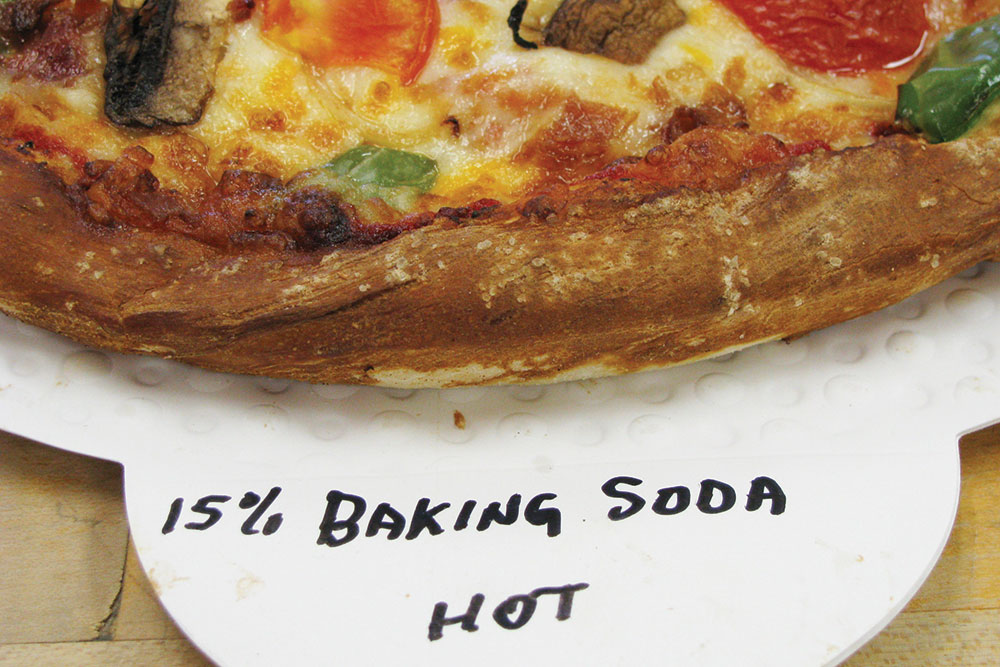QUESTION:
What’s the secret to a good pretzel pizza crust?
ANSWER:
Lately, everyone’s talking about pretzel this and pretzel that. Pretzel buns for hamburgers and hot dogs are all the rage. I was recently asked how to make pretzel breadsticks, too. Since pizza dough is so similar to pretzel dough, you can simply use your pizza dough to make the breadsticks and then brush them with an alkali solution—that’s how pretzels are made and the secret to their unique signature flavor and chew.
Historically, people have used sodium hydroxide to make the alkali solution, but it can inflict caustic burns if it gets onto your skin, and severe eye injury or even blindness if it gets into your eyes. Therefore, extreme caution must be exercised when using the sodium hydroxide solution. Instead, I tried a well-known alternative: baking soda (or sodium
bicarbonate). The baking soda solution imparts many of the pretzel-like characteristics to the finished product, and it’s much safer to work with. However, when comparing breadsticks made with the sodium hydroxide solution to those made with the baking soda solution, there was a slightly different (browner) crust color associated with the latter, and the flavor was a little different, too. Neither approach yielded a true “pretzel” taste until salt was applied to the dough right before baking; both solutions then yielded a flavor that we immediately identified as the classic pretzel flavor.
So what about pizza crusts? In our trials, we took a standard pizza crust formula and changed it to a pretzel crust by brushing the edge of the formed skin with a sodium hydroxide solution in one case and with a sodium bicarbonate solution in the second case. (We made a 2% sodium hydroxide solution and heated it to 190°F before brushing it onto the pizza skin.) In both cases the solutions were applied immediately before baking. We sprinkled kosher salt lightly on the edge and immediately baked the pizza in an air impingement oven just like our regular pizzas. (Warning: If you value your baking screens, disks or pans, don’t use them in this application. As the pie bakes, the highly caustic nature of the sodium hydroxide solution will eventually destroy any aluminum that it comes into contact with. Instead, use an ovenable baking tray designed for take-and-bake pizzas, or use a piece of baking parchment paper to hold the pizza during baking. Either way, spray release oil on the tray or parchment before you place the dough on it. Failure to do this will most likely result in the edge of the dough, where the alkali solution has been applied, sticking to the tray or paper.)
The resulting crusts had a deep, pretzel-like, mahogany color with recognizable pretzel flavor. We also tried the sodium hydroxide at 6% solution using cold water and applied the solution cold. This gave a very acceptable crust color and flavor, but it must be cautioned that both of these solutions are highly caustic and, at the very least, a respiration mask, goggles and plastic gloves should be worn while working with these solutions.
As a safer alternative to the sodium hydroxide, we also used a 15% solution of sodium bicarbonate (baking soda) and applied it to the dough both hot (190°F) and cold (room temperature/ambient). These solutions are much safer to work with, but the color and flavor were not quite as good as that from the sodium hydroxide solutions. The color came out more dark brown than mahogany, and the flavor, while good, was less identifiable as a pretzel taste. We did not see any significant advantage to using this soda solution hot as opposed to the cold preparation, so we recommend the cold/ambient approach for safer handling. Immediately after baking, we brushed the crust with melted clarified butter to create a gourmet pretzel-like presentation. (The accompanying photographs show the differences in color between each of the solutions tested.)
A pretzel crust makes for an interesting variation on standard pizza fare. Testers found the salted crust to be very acceptable in all cases. Different types of toppings can be applied to the edge of the pizza skin, including pretzel salt (slightly different from kosher salt), sesame seeds or poppy seeds. And a simple mustard makes a great dipping sauce.
Whatever type of caustic solution you use, be sure to follow all precautionary measures. Do not bake your pretzel crust pizzas on a metal pan; instead, use an oiled, ovenable paperboard tray or an oiled silicone baking sheet. For the best pretzel flavor, we think a salt topping works best, but other toppings can be used. Be sure to use a sanitary, plastic bristle brush to apply the caustic solution to the dough, because the solution can potentially destroy a natural bristle brush. Finally, when forming the dough, we got the best appearance and presentation with a raised or beaded edge as opposed to a flat or nonraised edge.
One last note: I would like to thank my fellow PMQ columnist Jeff Zeak (Zeak’s Tweaks) for his assistance in the lab as we developed this data and Renee Boeckman for her assistance with the photography.













